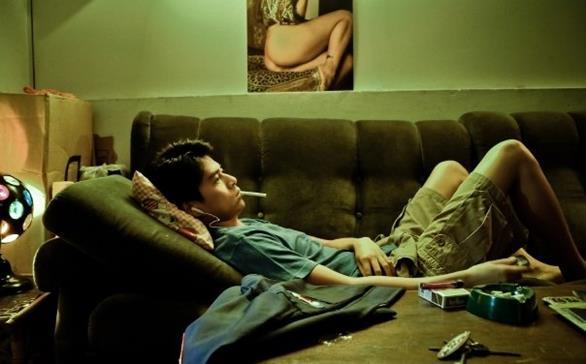Lav Diaz struck by incurable stage fright? Must be melancholia. So he got frequent collaborator, actress
Angeli Bayani, to read a little something he wrote for the Italian Film Festival in Manila, October 14, 2009. I shall say no more. Below is the entire speech reposted from the
Encantos blog:
By Lav Diaz
This piece will not be long. I timed it. It shall be just two minutes.
Okay, it will be a little bit longer. I am writing this piece in a very organic way, no apologies-stream of consciousness manner. This is free cinema.
I hate speeches to be very honest. Besides an incurable stage freight, I would rather much prefer to just play guitar with my back behind the crowd or be behind the camera than talk in front of people who would just be hearing another fool’s hyperbole and self-important chatter.
I received this request to deliver a speech here as a guest of honor.
What on earth is a guest of honor? Have you checked my background? The Board of Censors here in the Philippines banned my films, my two films that won at the Orizzonti of the Venice Film Festival. There’s nudity and sex, they said. Without proper critical viewing of my films by the honorable members of the Board of Censors, they deemed the films not appropriate for viewing here in their country of origin. They banned other works, too. And lately, they have been encroaching on the freedom of venues like the Adarna Theatre of the University of the Philippines. Benito Mussolini must be very proud.
I’ll say it again. Censorship is poison to cinema. Censorship is poison to the arts. Censorship is poison to culture. Censorship is a very feudal act. It is fascism.
The invitation also says that I should talk about my Venice experience. So, here’s a piece from a Filipino independent pornography filmmaker.
First, I would like to congratulate the 8th edition of the Italian Film Festival here in our beloved battered Philippines.
The Venice Film Festival or the Mostra Internazionale d'Arte Cinematografica di Venezia is the Mother of film festivals. It is the oldest film festival in the world. This tradition of mounting film festivals had its beginning in Venice, Italy in 1932. In 1952, the first Filipino film to compete, Manuel Conde’s Genghis Khan, exhibited in Venice. In 1985, Mike de Leon’s Sister Stella L. was shown at the festival. And in 2007, my film Death in the Land of Encantos competed and won Special Mention at the Orizzonti section of the festival. The following year, in 2008, my film Melancholia, competed in the same section and won the Orizzonti Prize. This year, Briliante Mendoza’s Lola was a Philippine entry at the Main Competition and Pepe Diokno’s Engkwentrocoveted two prizes, the Orizzonti Prize and the Luigi di Laurentii Lion of the Future Prize. Despite the dearth of our participation in the seventy six years existence of the Mostra, only six films to date, we have had a very triumphant and respectable run. Long live, Philippine cinema, indeed! And I would like to point out that despite the absence of state support in our cultural struggle, in the state’s sheer ignorance on the very important role of the arts in educating our people, cultural workers, especially artists and activists, persevere in pursuing greater discourse and praxis in this vast wasteland called the Philippines.
A Venice attendance is every filmmaker’s dream. If you are into aesthetic exercise, world cinema offers a load of great and incendiary works. And if you have celebrity skin, Hollywood’s killer vanity and fashion’s hallucinatory sheen is just everywhere. You can check the stately hotel where Thomas Mann wrote Death in Venice. A walk in Venice is a time machine ride with its old structures, art centers and canals. A boat ride is a rock ‘n roll experience.
More than the festivities and the city, Italy gave the world its great cinema culture. Roberto Rossellini, Michaelangelo Antonioni, Federico Fellini, Luchino Visconti, Pier Paolo Pasolini, Vittorio de Sica, Ermanno Olmi, Bernardo Bertolucci, Sergio Leone. That venerable list is continued by modern auteurs like Gianni Amelio, Giuseppe Tornatore, Marco Bellocchio, Paolo Sorrentino, Gabriele Salvatores and a lot more.
Italian cinema has given us many of the greatest models and paradigms--Open City, Paisan, Stromboli, L’Avventura, La Notte, L’eclisse, The Leopard, The Gospel According to St. Matthew, 8 ½, La Dolce Vita, Umberto D., Bicycle Thief, The Conformist, The Tree of Wooden Clogs, L’America. These works are incomparable masterpeices. These works set the standard by which the greater aesthetic discourse in cinema will continue to be measured upon till cinema is not dead. Yes, cinema will not die. We have Italian Cinema. Cinema will not die, we have Philippine cinema.
In one interview, Antonioni said: "I would not want to say. Or perhaps I do not know."
And I want to say this, allow me please: “Fuck profit motive in cinema!”
We just hope that this year’s edition will measure up to the greater tradition of cinema.
I will forever honor the memory of the great martyr, Alexis Tioseco… for the struggle toward a greater Philippine Cinema. Nika Bohinc will forever be in our hearts.
Again, mabuhay to the 8th year of the Italian Film Festival.
Salamat po.
(Read by Angeli Bayani, lead actress of Death in the Land of Encantos and Melancholia, during the Opening Ceremonies of the 8th Italian Film Festival in Manila, October 14, 2009)
------------------
Kudos,
Encantos!






















